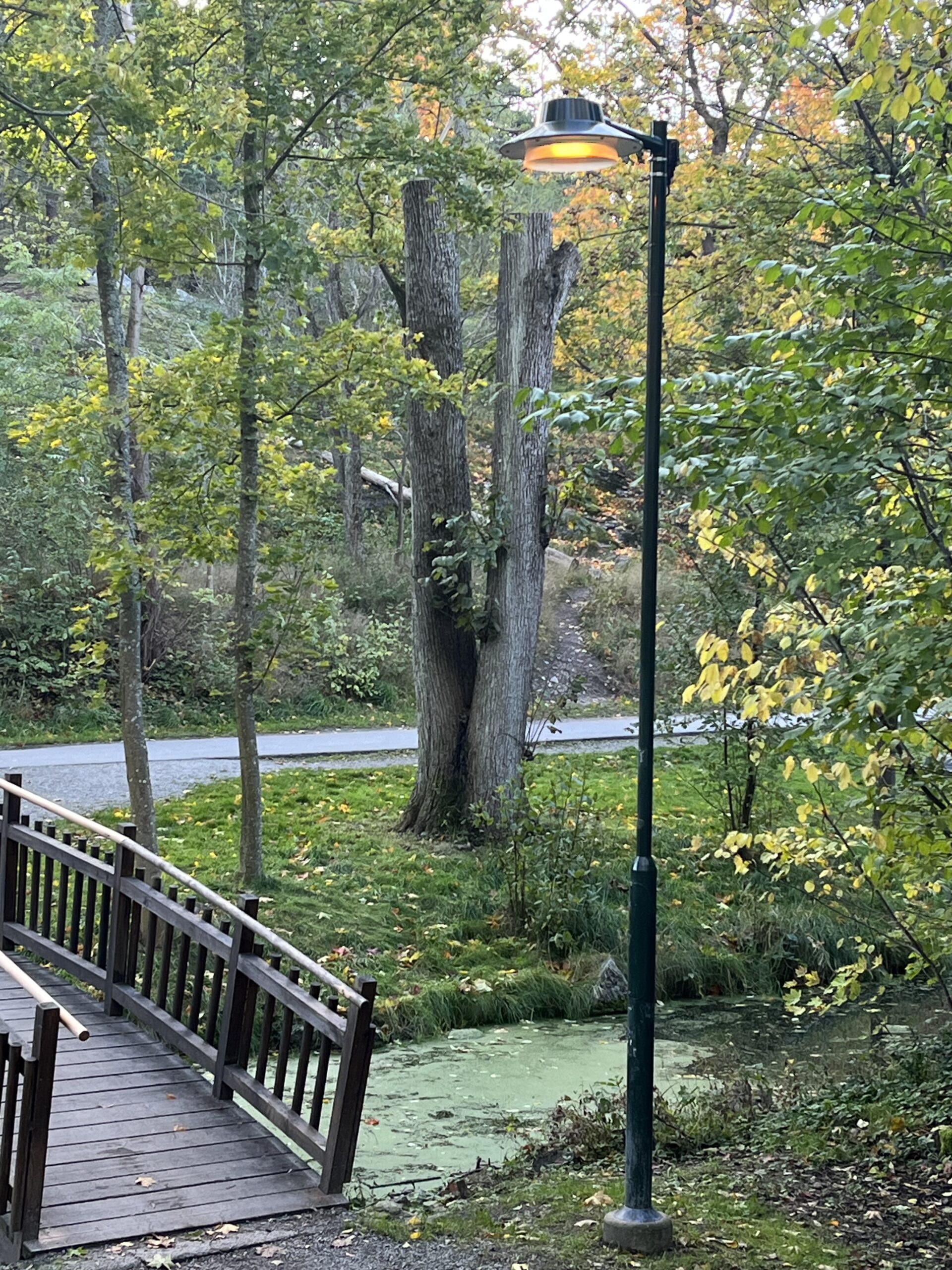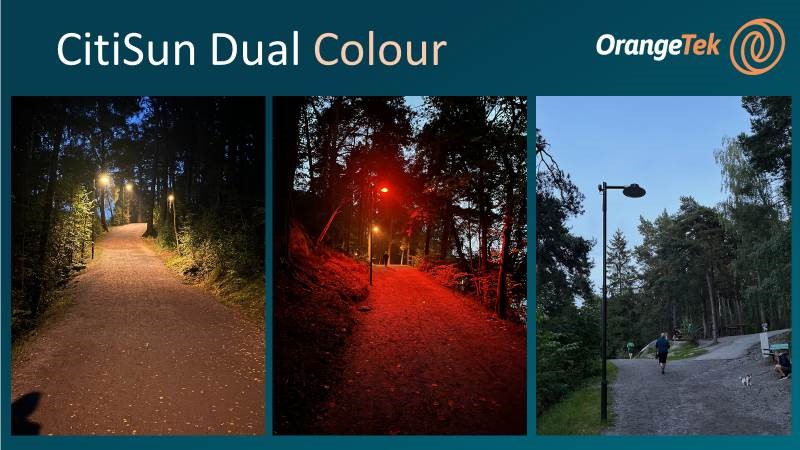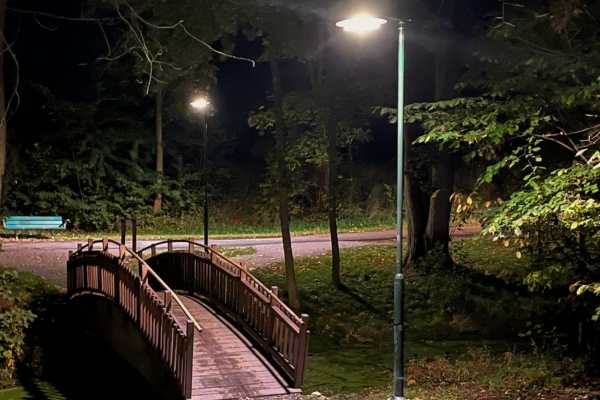By Orangetek
The City of Stockholm in Sweden has embarked on a groundbreaking project to assess and better control the impact of lighting on local biodiversity with a lighting project involving colour and presence-controlled lighting.

Environmental Context
The Swedish capital aims to become fossil-free and climate-positive by 2040, with the city itself becoming fossil-free by 2030. Key to this vision is not only reducing its carbon footprint but also nurturing a healthy environment for its residents and wildlife.
To bring these ambitious goals to fruition, Stockholm has crafted an “Action Plan for Biological Diversity in the City of Stockholm.” This initiative has given rise to a series of actions aimed at preserving and enhancing biodiversity within the urban environment.
Lighting as a Conservation Tool
One innovative aspect of this broader initiative is a focus on lighting as a potential conservation tool. This project is a collaboration between various departments at the City of Stockholm and has been driven by Mattias Bovin of the Environmental Administration and Anders Hedlund of the Traffic Office.
Commencing early in 2022, the project is set to conclude with a final report in mid-2024. The overarching goal is to establish guidelines for lighting practices that harmonize with and support biodiversity.
The Genesis of the Project
In 2022, Stockholm launched a pilot project grounded in international research and reports. The project’s central objective was to assess how colour and presence-controlled lighting could affect the activity of bats within the “Årstskogen” nature area, strategically situated in the heart of the city. The collaboration with the Environmental Administration ensures that ecological considerations remained at the forefront of the project’s design and implementation.
Technical Innovations
To comprehensively evaluate the impact of lighting on the local bat population, two distinct technical solutions were developed and tested:
Option 1: This approach involved equipping luminaires with two different colour temperatures, 3000K (warm) and 2200K (very warm). Both light sources were activated at dusk (approximately 1000 + 1000 lumens), with the 3000K source turning off five hours before and after midnight. The 2200K light, emitting less blue light, aimed to explore whether a simpler and cost-effective lighting solution could still provide adequate illumination while being more favourable to bats.
Option 2: In this configuration, luminaires featured monochrome amber LED lights at 590nm (approximately 500 lumens) and 3000K (around 2000 lumens). The amber LED remained active throughout the night, while the 3000K component was controlled by presence sensors and illuminated a section of 150-200 meters before and after the detection location. The amber LED’s minimal biological impact made it ideal as a guiding light, while the 3000K source was essential for safety and enhancing the sense of security.

On-the-Ground Measurements
Two distinct park roads, “the brook” and “the forest,” were selected for measurement and observation. Pre-measurements of bat activities were conducted in the summer of 2022. “The brook” had previously been illuminated with round radiant luminaires using ceramic metal halide at 3000K and bats had been observed in this location in the past. In contrast, “the forest” had remained unlit, but accessibility and safety concerns had prompted calls for illumination. The bat activity measurements for both sites were again conducted in the summer of 2023, providing crucial data for evaluating the impact of the new lighting solutions.
Audio boxes have been installed to record the sounds made by bats. Once the data and sounds have been evaluated, the city will be able to better understand the different bat types, quantities and activity in this area.
Looking Ahead
“The brook” has undergone a transformation with lighting according to Option 2, while “the forest” now utilizes the lighting solution from Option 1. These test results will offer insights into the effectiveness of these different lighting configurations and their ecological implications. Moreover, this experiment could inform future lighting decisions across the city.
Committed to Sustainability
It’s important to note that these lighting solutions are based on reports and studies, rather than established scientific consensus. The project remains open to new information that may refine its guidelines. All adjustments for biological diversity are founded on thorough site investigations by ecologists, who provide guidance on species and their lighting sensitivity. The project is also exploring how residents utilize the routes in terms of their experiences and feelings of safety.
A Rich Tapestry of Life
With 56 unique animal species identified in the area, including 18 near-threatened, 5 vulnerable, and 3 endangered, Stockholm’s commitment to preserving biodiversity is evident. This project takes on added significance as the city is currently home to eleven species of bats, constituting 79% of the bat species observed in the county and 61% of those observed in the country since 2000. Prominent among them are the northern bat, the pygmy pipistrelle, and the water bat.
A Brighter Future for Biodiversity
It is anticipated that the findings should be reported in the middle of 2024 once the evaluation of field observations and data is complete. In the meantime, data collection is continuing.
Stockholm’s forward-thinking project is a beacon of hope for environmental conservation, hoping to demonstrate that even urban lighting can play a vital role in supporting biodiversity. With innovative approaches and a commitment to sustainability, the city is taking strides toward its vision of a fossil-free, climate-positive future while safeguarding its natural treasures.
Parts of the project have been enabled by a new luminaire called ”Citisun Dual Colour” by OrangeTek. This dual colour luminaire, one of the first of its kind, has the ability to change the colour temperature balance using smart street lighting controls and sensors.
It serves as a promising example of the future of lighting, designed to minimize environmental impact and prioritize the well-being of both wildlife and the community. By shedding light on the delicate balance between human needs and the needs of nature, Stockholm is pioneering a more harmonious coexistence between city life and the wild world beyond.














